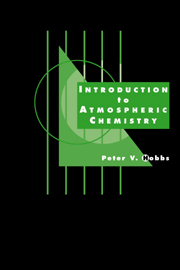Book contents
- Frontmatter
- Contents
- Preface
- 1 Evolution of the Earth's atmosphere
- 2 Half-life, residence time, and renewal time of chemicals in the atmosphere
- 3 Present chemical composition of the atmosphere
- 4 Interactions of solar and terrestrial radiation with atmospheric trace gases and aerosols
- 5 Sources, transformations, transport, and sinks of chemicals in the troposphere
- 6 Atmospheric aerosols
- 7 Cloud and precipitation chemistry
- 8 Tropospheric chemical cycles
- 9 Air pollution
- 10 Stratospheric chemistry
- Appendix I Exercises
- Appendix II Answers to exercises in Appendix I and hints and solutions to the more difficult exercises
- Appendix III Atomic weights
- Appendix IV The International System of Units (SI)
- Appendix V Some useful numerical values
- Appendix VI Suggestions for further reading
- Index
5 - Sources, transformations, transport, and sinks of chemicals in the troposphere
Published online by Cambridge University Press: 05 June 2012
- Frontmatter
- Contents
- Preface
- 1 Evolution of the Earth's atmosphere
- 2 Half-life, residence time, and renewal time of chemicals in the atmosphere
- 3 Present chemical composition of the atmosphere
- 4 Interactions of solar and terrestrial radiation with atmospheric trace gases and aerosols
- 5 Sources, transformations, transport, and sinks of chemicals in the troposphere
- 6 Atmospheric aerosols
- 7 Cloud and precipitation chemistry
- 8 Tropospheric chemical cycles
- 9 Air pollution
- 10 Stratospheric chemistry
- Appendix I Exercises
- Appendix II Answers to exercises in Appendix I and hints and solutions to the more difficult exercises
- Appendix III Atomic weights
- Appendix IV The International System of Units (SI)
- Appendix V Some useful numerical values
- Appendix VI Suggestions for further reading
- Index
Summary
In this chapter we will consider the sources, transformations, transport, and sinks of chemicals in the natural troposphere. Our emphasis will be on gases; aerosols will be considered in more detail in Chapter 6.
Sources
The principal natural sources of gases in the troposphere are the biosphere, the solid Earth, the oceans, and in situ formation in air from other chemical species. These sources are discussed, in turn, in the following subsections.
Biological
Even though the biosphere contains only a small fraction of the total reservoirs of most chemicals on Earth, it plays a major role in determining the abundances and transport of many gases in the atmosphere. The smells associated with flowers and other forms of vegetation provide direct evidence that biota emit chemicals into the air. Some important biological sources of trace gases that enter the atmosphere are:
Photosynthesis in plants (Reaction (1.1)), which is responsible for virtually all of the oxygen in the atmosphere.
Respiration (the reverse of Reaction (1.1)), which releases CO2 into the air. This can be seen, on a seasonal basis, in Figure 1.1 where the decline of CO2 in the summer months is due to its uptake by plants during photosynthesis. The rise of CO2 in winter and early spring (Fig. 1.1) is due to respiration, and the decay of leaf litter and other dead plant material. This “breathing” of the atmosphere can also be detected in diurnal fluctuations in CO2; CO2 concentrations in forests can be ~35ppmv higher at night than in the day.
[…]
- Type
- Chapter
- Information
- Introduction to Atmospheric Chemistry , pp. 63 - 81Publisher: Cambridge University PressPrint publication year: 2000

